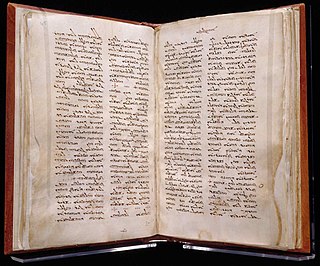
The Diatessaron is the most prominent early gospel harmony. It was created in the Syriac language by Tatian, an Assyrian early Christian apologist and ascetic. Tatian sought to combine all the textual material he found in the four gospels - Matthew, Mark, Luke, and John - into a single coherent narrative of Jesus's life and death. However, and in contradistinction to most later gospel harmonists, Tatian appears not to have been motivated by any aspiration to validate the four separate canonical gospel accounts; or to demonstrate that, as they stood, they could each be shown as being without inconsistency or error.
The New Testament (NT) is the second division of the Christian biblical canon. It discusses the teachings and person of Jesus, as well as events relating to first-century Christianity. The New Testament's background, the first division of the Christian Bible, is called the Old Testament, which is based primarily upon the Hebrew Bible; together they are regarded as Sacred Scripture by Christians.

The Bible has been translated into many languages from the biblical languages of Hebrew, Aramaic, and Greek. As of September 2023 all of the Bible has been translated into 736 languages, the New Testament has been translated into an additional 1,658 languages, and smaller portions of the Bible have been translated into 1,264 other languages according to Wycliffe Global Alliance. Thus, at least some portions of the Bible have been translated into 3,658 languages.
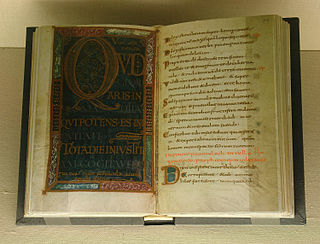
A psalter is a volume containing the Book of Psalms, often with other devotional material bound in as well, such as a liturgical calendar and litany of the Saints. Until the emergence of the book of hours in the Late Middle Ages, psalters were the books most widely owned by wealthy lay persons. They were commonly used for learning to read. Many Psalters were richly illuminated, and they include some of the most spectacular surviving examples of medieval book art.

Turpan, generally known in English as Turfan, is a prefecture-level city located in the east of the autonomous region of Xinjiang, China. It has an area of 69,759 km2 (26,934 sq mi) and a population of 693,988 (2020). The historical center of the prefectural area has shifted a number of times, from Yar-Khoto to Qocho and to Turpan itself.
The Sogdian language was an Eastern Iranian language spoken mainly in the Central Asian region of Sogdia, located in modern-day Uzbekistan, Tajikistan, Kazakhstan and Kyrgyzstan; it was also spoken by some Sogdian immigrant communities in ancient China. Sogdian is one of the most important Middle Iranian languages, along with Bactrian, Khotanese Saka, Middle Persian, and Parthian. It possesses a large literary corpus.

A polyglot is a book that contains side-by-side versions of the same text in several different languages. Some editions of the Bible or its parts are polyglots, in which the Hebrew and Greek originals are exhibited along with historical translations. Polyglots are useful for studying the history of the text and its interpretation.

The Manichaean script is an abjad-based writing system rooted in the Semitic family of alphabets and associated with the spread of Manichaeism from southwest to central Asia and beyond, beginning in the third century CE. It bears a sibling relationship to early forms of the Pahlavi scripts, both systems having developed from the Imperial Aramaic alphabet, in which the Achaemenid court rendered its particular, official dialect of Aramaic. Unlike Pahlavi, the Manichaean script reveals influences from the Sogdian alphabet, which in turn descends from the Syriac branch of Aramaic. The Manichaean script is so named because Manichaean texts attribute its design to Mani himself. Middle Persian is written with this alphabet.
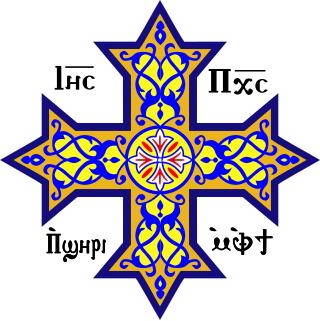
There have been many Coptic versions of the Bible, including some of the earliest translations into any language. Several different versions were made in the ancient world, with different editions of the Old and New Testament in five of the dialects of Coptic: Bohairic (northern), Fayyumic, Sahidic (southern), Akhmimic and Mesokemic (middle). Biblical books were translated from the Alexandrian Greek version.
A biblical manuscript is any handwritten copy of a portion of the text of the Bible. Biblical manuscripts vary in size from tiny scrolls containing individual verses of the Jewish scriptures to huge polyglot codices containing both the Hebrew Bible (Tanakh) and the New Testament, as well as extracanonical works.
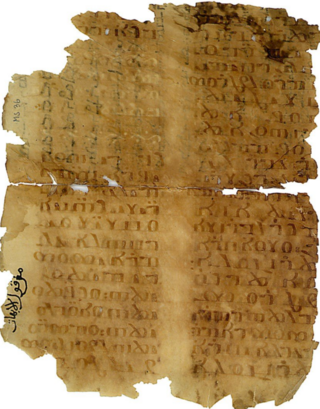
Christian Palestinian Aramaic was a Western Aramaic dialect used by the Melkite Christian community, probably of Jewish descent, in Palestine, Transjordan and Sinai between the fifth and thirteenth centuries. It is preserved in inscriptions, manuscripts and amulets. All the medieval Western Aramaic dialects are defined by religious community. CPA is closely related to its counterparts, Jewish Palestinian Aramaic (JPA) and Samaritan Aramaic (SA). CPA shows a specific vocabulary that is often not paralleled in the adjacent Western Aramaic dialects.
"They have pierced my hands and my feet", or "They pierced my hands and my feet" is a phrase that occurs in some English translations of Psalm 22:16.
Arabic translations of the Bible constitute one of the richest traditions of Bible transmission. Translations of the Bible into Arabic were produced by Arabic-speaking Jews, Christians, and Samaritans. Even though Arabic was spoken by Jews and Christians before the advent of Islam, running Arabic translations of the Bible are attested in manuscripts only from the 9th century CE onwards. So far, no evidence could be adduced that Arabic Bible translations were available at that time. Before that, quotations from the Bible were used in Arabic especially by Christians.

Syriac is a dialect of Aramaic. Portions of the Old Testament were written in Aramaic and there are Aramaic phrases in the New Testament. Syriac translations of the New Testament were among the first and date from the 2nd century. The whole Bible was translated by the 5th century. Besides Syriac, there are Bible translations into other Aramaic dialects.

Bible translations in the Middle Ages went through several phases, all using the Vulgate. In the Early Middle Ages, written translations tended to be associated with royal or episcopal patronage, or with glosses on Latin texts; in the High Middle Ages with monasteries and universities; in the Late Middle Ages, with popular movements which caused, when the movement were associated with violence, official crackdowns of various kinds on vernacular scripture in Spain, England and France.
Bible translations into Persian have been made since the fourth or fifth century, although few early manuscripts survive. There are both Jewish and Christian translations from the Middle Ages. Complete translations of the Hebrew Bible and Greek New Testament from original languages were first made in the 19th century by Protestant missionaries.
The earliest known Christian texts in Old Uyghur are known from manuscript fragments uncovered in the Turfan oasis. There are approximately fifty fragments written in Old Uyghur. An early Uyghur translation of the New Testament and the Psalms may have been done in the 14th century by Giovanni da Montecorvino, papal envoy to the Mongols who became Roman Catholic archbishop of Khanbaliq in 1307.
The Bible was translated into Old Nubian during the period when Christianity was dominant in Nubia. Throughout the Middle Ages, Nubia was divided into separate kingdoms: Nobadia, Makuria and Alodia. Old Nubian was the standard written form in all three kingdoms. Of the living Nubian languages, it is modern Nobiin which is the closest to Old Nubian and probably its direct descendant.
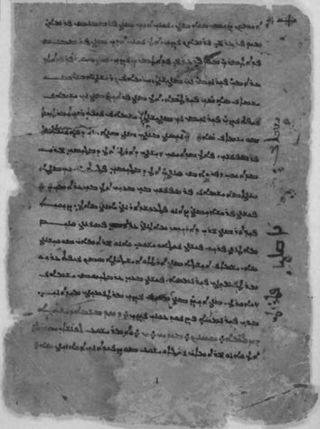
Bulayïq is a locality and archaeological site in central Xinjiang province in western China. It is located 10km north of Turpan city in the foothills of the Tien-shan Mountains. It is also known as Bīlayuq.

Early translations of the New Testament – translations of the New Testament created in the 1st millennium. Among them, the ancient translations are highly regarded. They play a crucial role in modern criticism of New Testament's text. These translations reached the hands of scholars in copies and also underwent changes, but the subsequent history of their text was independent of the Greek text-type and are therefore helpful in reconstructing it. Three of them – Syriac, Latin, Coptic – date from the late 2nd century and are older than the surviving full Greek manuscripts of the New Testament. They were written before the first revisions of the Greek New Testament and are therefore the most highly regarded. They are obligatorily cited in all critical editions of the Greek text-type. Translations produced after 300 are already dependent on the reviews, but are nevertheless important and are generally cited in the critical apparatus. The Gothic and Slavic translations are rarely cited in critical editions. Omitted are those of the translations of the first millennium that were not translated directly from the Greek original, but based on another translation.